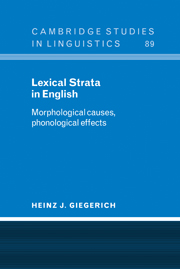Book contents
- Frontmatter
- Contents
- Acknowledgements
- 1 A requiem for Lexical Phonology?
- 2 Affix-driven stratification: the grand illusion
- 3 Principles of base-driven stratification
- 4 Derving the Strict Cyclicity Effect
- 5 Phonology and the literate speaker: orthography in Lexical Phonology
- 6 [r]-sandhi and liaison in RP
- 7 Input vowles to [r]-sandhi: RP and London English
- 8 Syllables and strata
- Notes
- References
- Subject index
- Index of words, roots and affixes
3 - Principles of base-driven stratification
Published online by Cambridge University Press: 22 September 2009
- Frontmatter
- Contents
- Acknowledgements
- 1 A requiem for Lexical Phonology?
- 2 Affix-driven stratification: the grand illusion
- 3 Principles of base-driven stratification
- 4 Derving the Strict Cyclicity Effect
- 5 Phonology and the literate speaker: orthography in Lexical Phonology
- 6 [r]-sandhi and liaison in RP
- 7 Input vowles to [r]-sandhi: RP and London English
- 8 Syllables and strata
- Notes
- References
- Subject index
- Index of words, roots and affixes
Summary
Further failings of affix-driven stratification
The single major point made in the preceding chapter was that, in the face of the dual stratum-affiliation displayed by a substantial number of English affixes, the hypothesis of affix-driven lexical stratification cannot be sustained. But while the failure of a large number of affixes to serve unambiguously in the definition of lexical strata suffices alone to discredit the affix-driven model, that model has a number of further, apparently unrelated, weaknesses on the morphological side that are worth noting – especially given that the replacement model to be proposed in this chapter must of course seek to avoid all the weaknesses of the current model. I hope to show in this section that those further weaknesses of the affix-driven model all amount to a systematic failure to explain certain stratification-related facts; further below I shall demonstrate that these facts are amenable to a unified explanation that follows automatically from a stratification model whose morphological diagnostics arise from characteristics of the affixation base (along the lines sketched in Section 2.2.2 above) rather than from the diacritic marking of affixes. I shall refer to the replacement model that will be presented in this chapter as one of ‘base-driven stratification’.
Stratification, stacking restrictions and etymology
One of the outcomes of Chapter 2 has been the recognition that any significance attached to the perceived effects of the AOG (Siegel 1974; Selkirk 1982b) is less straightforward regarding lexical stratification than has been assumed in the literature.
- Type
- Chapter
- Information
- Lexical Strata in EnglishMorphological Causes, Phonological Effects, pp. 53 - 99Publisher: Cambridge University PressPrint publication year: 1999



